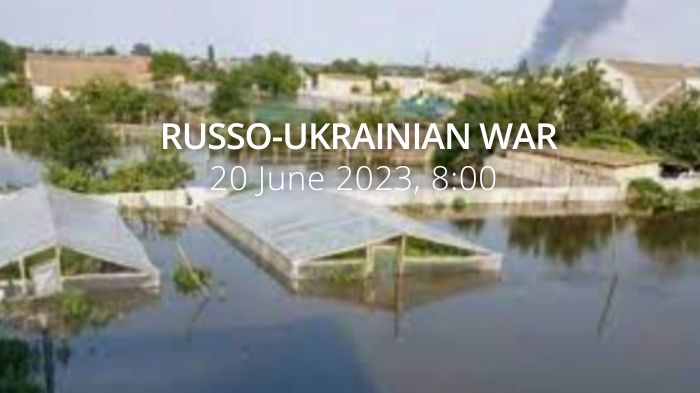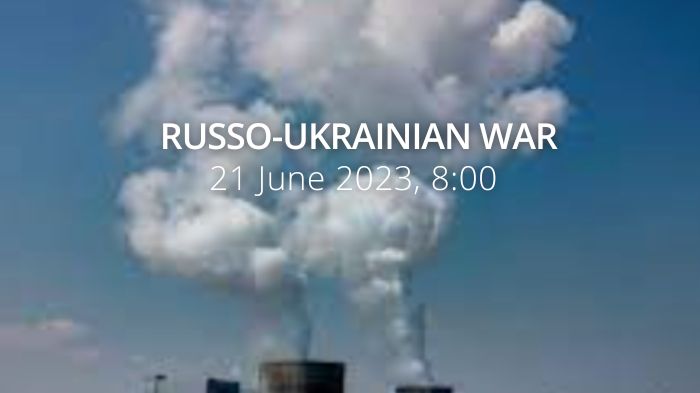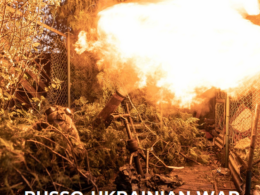Russia launches an overnight air attack on Ukraine. Ukrainian air defense shoots 28 out of 32 drones. Hundreds of Russian-occupied Oleshky residents died because the Russians refused to evacuate them after blowing up Kakhovka HPP.
Daily overview — Summary report, June 20

The General Staff’s operational update regarding the Russian invasion as of 18.00 pm, June 20, 2023 is in the dropdown menu below:
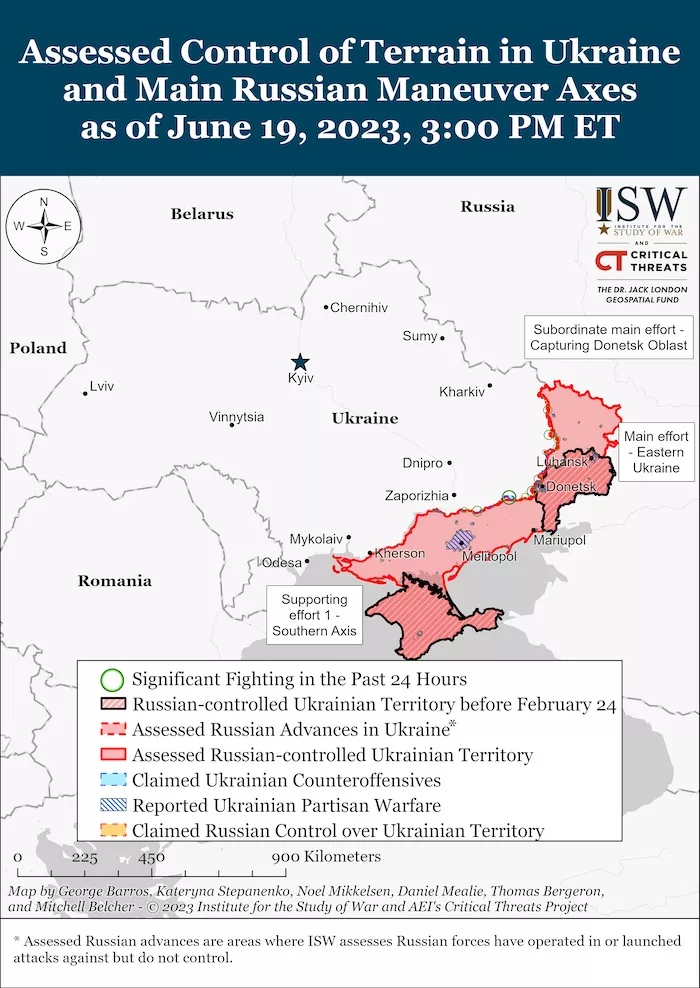
[The Russian Federation continues to kill the civilian population of Ukraine and violates laws and customs of war; uses terror tactics, carries out strikes, and shells both military and civilian targets.]
Tonight, Russian terrorists launched another massive air and missile attack on Ukraine. Previously, 32 "shaheeds" out of 35 launched by the enemy were destroyed. Also, 7 S-300 missiles were used by the occupiers in Zaporizhzhia and its surroundings - the information is currently being clarified.
On June 20, the enemy used 4 Caliber cruise missiles and 4 Iranian strike UAVs "Shahed-136/131". All 8 air targets were destroyed.
In addition, the enemy carried out more than 45 airstrikes and carried out about 70x MLRS attacks on Ukrainian settlements and Ukrainian Defense Forces. Unfortunately, civilians suffered.
The threat of missile and air strikes across Ukraine remains high.
The enemy continues to focus its main efforts on the Lyman, Bakhmut, Avdiivka, and Marinka axes, and heavy battles continue. During the past day, 45 combat clashes took place.
- Volyn’ and Polissya axes: [the operational situation has not changed significantly. There are no signs of the formation of offensive groupings. On the training grounds of the Republic of Belarus, combat training and coordination of units of the Russian troops are underway after which they are sent to the frontlines on the territory of Ukraine.]
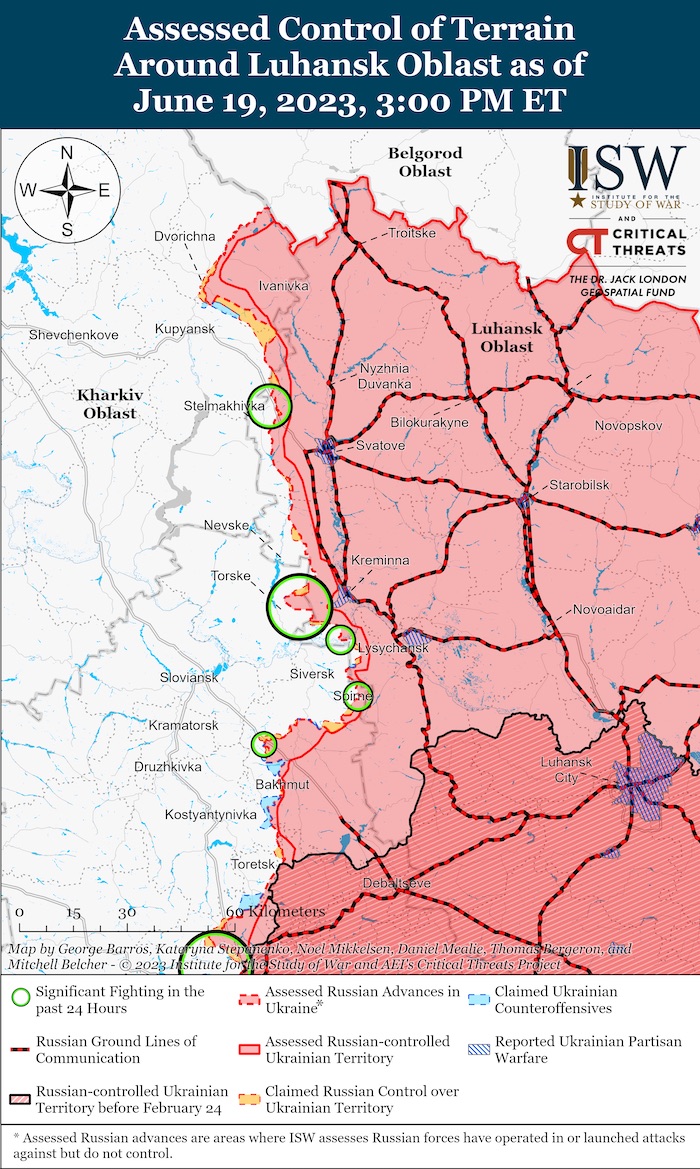
- Sivershchyna and Slobozhanshchyna axes: the enemy forces launched an airstrike on the Budarka settlement, Kharkiv Oblast. They shelled with mortars and artillery Karpovychi, Hremyach, Chernihiv Oblast; Seredyna-Buda, Progres, Chuykivka, Basivka, Boyaro-Lezhachi, Turya of the Sumy Oblast, as well as Huryiv Kozachok, Udy, Chervona Zorya, Kozacha Lopan’, Hlyboke, Oliynikovo, Liptsi, Ternova, Staritsa, Ohirtsevo, Hatyshche, Vovchans’k, Zybyne, Okhrimivka, Varvarivka, Nesterne, Budarky, Krasny Yar in Kharkiv Oblast.
- Kupiansk axis: the enemy forces carried out an airstrike at Kislivka, Kharkiv Oblast. Krasne Pershe, Novomlyns’k, Dvorichna, Zapadne, Kislivka, and Berestov of the Kharkiv Oblast were shelled by artillery and mortars.
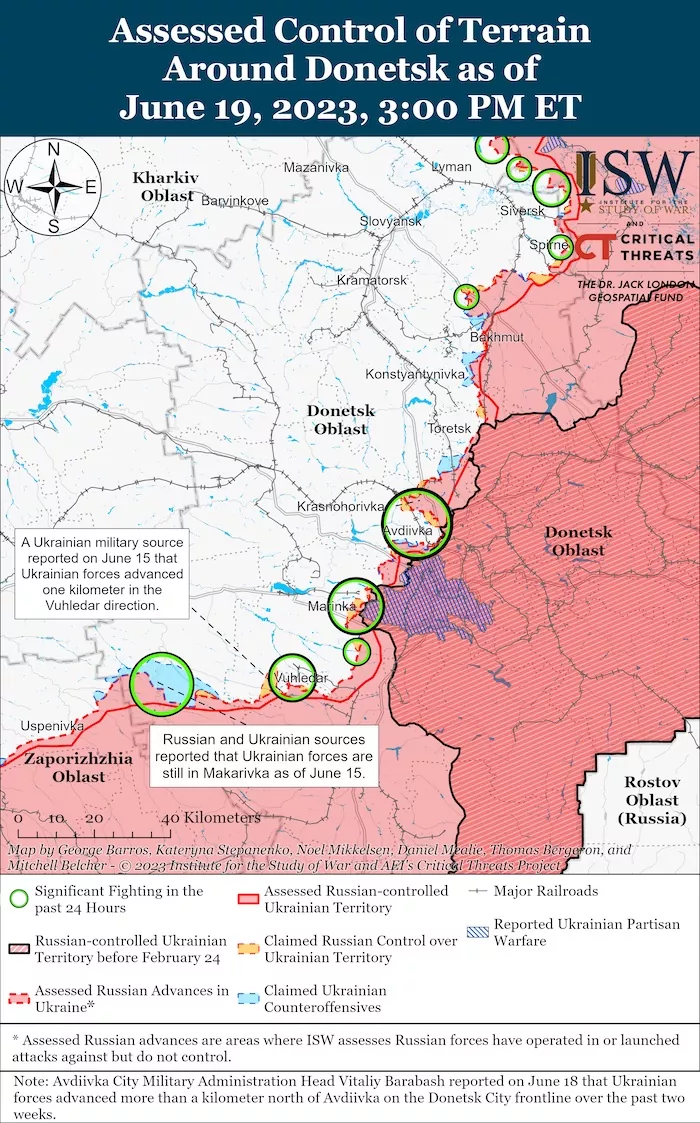
- Lyman axis: Russians carried out offensives in the vicinities of Yampolivka, Torsky, Hryhorivka, Spirny and west of Dibrova of the Donetsk Oblast, albeit without success. They launched an airstrike at Yampil, Bilogorivka, Siversk and Spirne. Stelmakhivka, Nevske, Belogorivka of the Luhansk Oblast and Tors’ke, Serebryanka, Verkhn’okam’ians’ke and Rozdolivka of the Donetsk Oblast were under artillery fire.
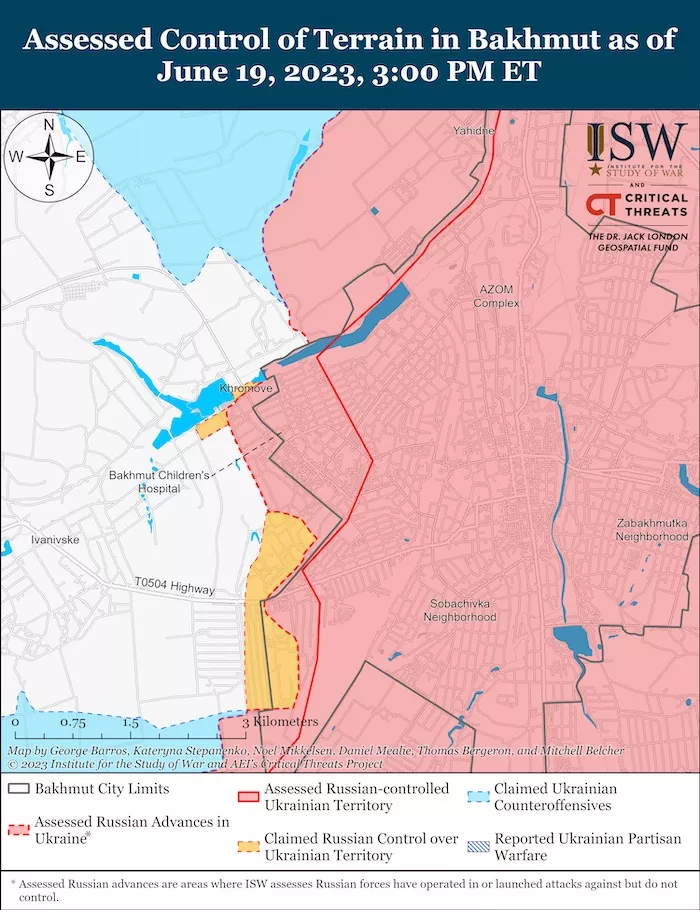
- Bakhmut axis: the enemy forces carried out unsuccessful offensive operations near Orikhovo-Vasylivka, Donetsk Oblast. They carried out airstrikes at Severny and Toretsk. Areas of settlements of Vasyukivka, Orikhovo-Vasylivka, Bogdanivka, Kalynivka, Chasiv Yar, Ivanivs’ke, Ozaryanivka, Bila Hora, Kostiantynivka, Druzhba, and Pivnichne of the Donetsk Oblast were shelled by enemy artillery.
- Avdiivka axis: the adversary carried out unsuccessful offensives in the vicinities of Avdiivka. They shelled Orlivka, Avdiivka, Karlivka, Pervomaiske, Nevelske of the Donetsk Oblast.
- Marinka axis: during the past day, our defenders repelled all enemy attacks in the vicinities of Krasnohorivka, Marinka, and Pobieda. Near the last two settlements, the enemy launched airstrikes. Moreover, Russians shelled Krasnohorivka, Georgiivka, Mar’inka and Pobyeda of the Donetsk Oblast.
- Shakhtarske axis: the enemy forces carried out offensive operations on the Novomykhailivka axis, albeit without success. They launched airstrikes in the vicinities of Velika Novosilka and Zolotaya Niva. The adversary shelled Paraskoviivka, Kostiantynivka, Novomykhailivka, Vodyane, and Vugledar in the Donetsk Oblast.
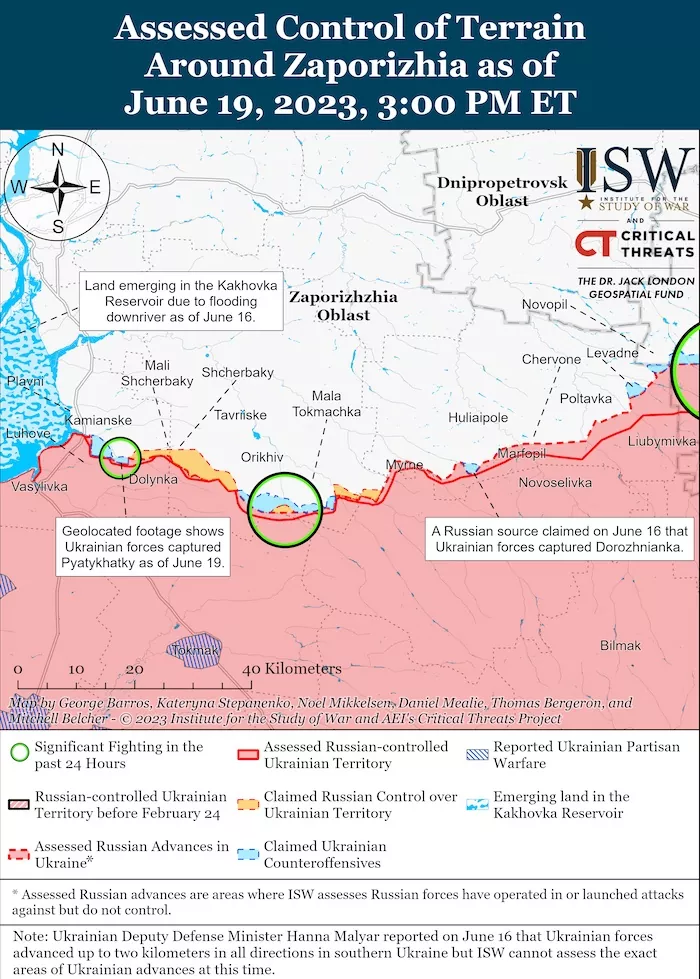
- Zaporizhzhia and Kherson axes: Russian forces are on the defensive. The enemy carried out airstrikes at Levadny, Zelene Pole, Novodarivka, and Malaya Tokmachka of Zaporizhzhia Oblast. They shelled the settlements of Blagodatne, Makarivka, Storozheve, Vremivka, Vilne Pole, Zelene Pole, Novopil’ of the Donetsk Oblast; Temyrivka, Levadne, Olgivs’ke, Chervone, Hulyaipole, Zaliznychne, Charivne, Novoandriivka, Shcherbaki, Stepove, Pyatikhatky, Lobkovo, Kam’ians’ke of the Zaporizhzhia Oblast; Beryslav, Tomarine, Kozats’ke, Burgunka, Ivanivka, Antonivka, Kherson, Dniprovs’ke, Kizomys and Sofiivka in the Kherson Oblast.
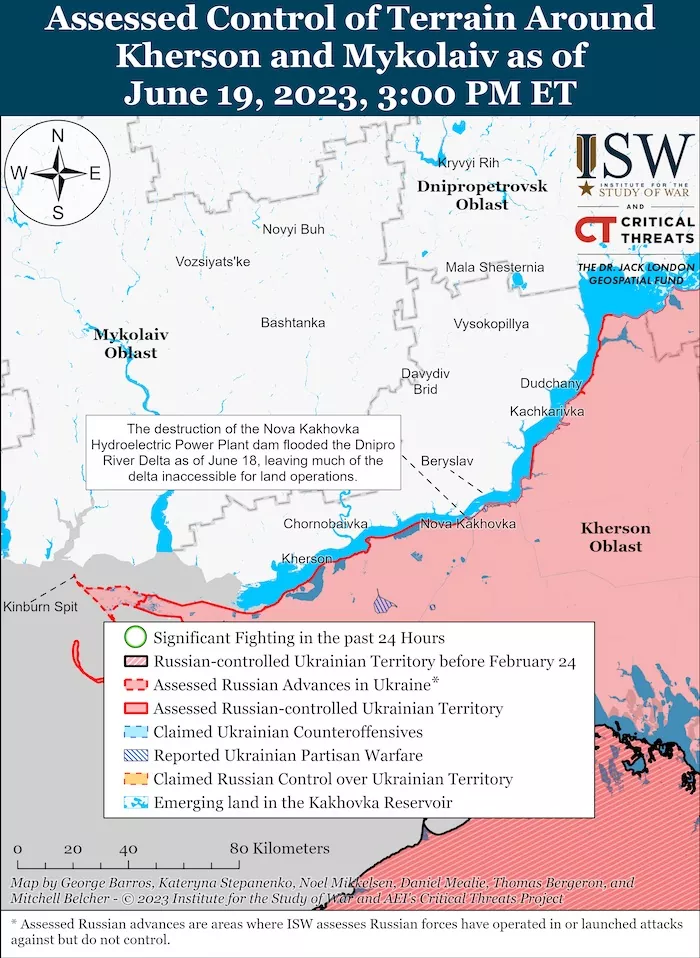
[The Russian occupying forces continue to suffer heavy losses on the battlefield. As a result, the enemy continues to convert civilian facilities in the temporarily occupied territories of Ukraine into medical facilities. Thus, the occupiers turned the secondary school in the village of Rozhivka, Zaporizhzhia Oblast, into a military hospital. An operating room was placed in the attached dining room, and wards for the wounded were arranged in the classrooms. At the same time, this military hospital is used as a logistics hub for the redistribution of wounded and dead enemy servicemen. Heavily wounded soldiers and sergeants are being transported to medical facilities in Donetsk, Mariupol and Berdiansk by road transport. Wounded officers are transported to the Russian Federation by air.]
Ukrainian Air Force carried out 15 airstrikes on enemy manpower concentrations.
Ukrainian missile and artillery units hit 3 control points, 10 manpower and military equipment concentrations, 2 ammunition warehouses, 1 warehouse of fuel and lubricants, 15 artillery units at firing positions, 3 anti-air defence systems and 2 more important objects of the occupiers.
Military Updates
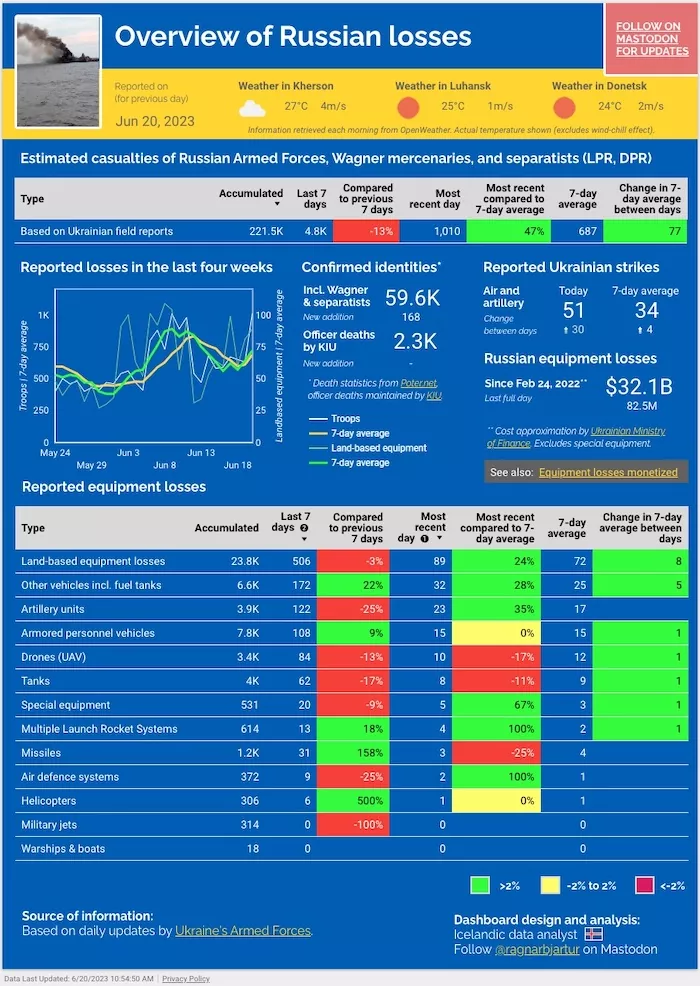
On the night of June 20, the enemy struck the military and infrastructure facilities of Ukraine with Iranian barrage ammunition "Shahed", the Ukrainian General Staff reports. “Launches were carried out from the northern and southern directions - the Bryansk region and the eastern coast of the Sea of Azov. In total, the occupiers used 35 attack drones. 32 were destroyed by the anti-aircraft defence.
Air defence today worked in most regions of Ukraine, however, the main direction of attack by Iranian drones was the Kyiv region. More than two dozen "shaheeds" were destroyed here. In addition, during the night, the Russian occupiers struck Zaporizhzhia with ballistic missiles - Iskander-M/S-300 missiles.”
Russia launches an overnight air attack on Ukraine from east to west, Reuters reports. “Russia launched a widespread overnight air attack on Ukraine targeting the capital and cities from east to west as most of the country spent the night with air raid sirens blasting for several hours. The General Staff of Ukraine's Armed Forces said that according to preliminary information, Ukraine's air defence systems shot down 28 out of 30 Iranian-made Shahed drones that Russia launched.
About 20 enemy targets were identified and destroyed by the forces and our air defence in the airspace around Kyiv, Serhiy Popko, head of the Kyiv military administration, said on the Telegram messaging app.
The military administration of Lviv, a city of about 700,000 people and 70 kms (43 miles) from the border with the NATO country of Poland, said Russia hit a critical infrastructure in the city, sparking fire. According to preliminary reports, there were no casualties.
Yuriy Malashko, head of the military administration of the Zaporizhzhia region in southeast Ukraine, said on the Telegram messaging app that Russia's raid targeted telecommunication infrastructure and agriculture and farming properties.There were no casualties reported in Zaporizhzhia. The top military command said that Russia launched seven missiles in the attack on Zaporizhzhia, according to preliminary reports.”
Ukraine's Armed Forces liberate Piatykhatky and 7 more settlements, Ukrainska Pravda reports. “Hanna Maliar, Deputy Minister of Defence, has reported that the Armed Forces of Ukraine have liberated eight settlements on the Berdiansk and Melitopol fronts, including the town of Piatykhatky.
In the course of two weeks of offensive operations on the Berdiansk and Melitopol fronts, during the specified period, units from the Tavriia Operational and Strategic Group of Forces have liberated 8 settlements, including Novodarivka, Levadne, Storozheve, Makarivka, Blahodatne, Lobkove, Neskuchne and Piatykhatky. Maliar emphasised that, in total, the units on the Tavriia front had advanced into the depths of the Russian forces by up to 7 kilometres, and the liberated area in the south is 113 square kilometres.
The Deputy Minister of Defence noted that the active operation of the Tavriia Operational and Strategic Group of Forces is ongoing. The enemy suffered significant losses over the past week. In particular, last week the enemy's losses on all fronts amounted to more than 4,600 killed and wounded, and in addition, our defenders captured over 80 of the aggressor’s fighters, Maliar concluded.”
The situation is difficult in Ukraine’s east, the enemy increased its forces – MoD, Ukrinform reports, citing Ukraine’s Deputy Minister of Defense Hanna Maliar. “The Russian occupying forces have increased troops and are trying to advance in the Lyman and Kupiansk directions. In addition, the enemy concentrated a significant number of airborne assault units in the east.
The situation in the East is difficult. The enemy has increased its forces and is conducting an active offensive in the Lyman and Kupiansk directions, trying to seize the initiative from us. High activity of enemy shelling is recorded. Fierce battles are ongoing, the report says.
According to Maliar, the enemy is not abandoning its plans to reach the borders of the Donetsk and Luhansk regions. Currently, this is the main direction of attack for the enemy. Therefore, it has focused a significant number of its units in the east, in particular the airborne assault units. Our troops act courageously in the conditions of the enemy's superiority in forces and means and do not allow the enemy to advance, the deputy minister of defence said.
Earlier, Hanna Maliar reported that in the Bakhmut direction, Ukrainian troops had advanced in several sections over the past week.”
New missile and drone attack on the night of June 19, the Ukrainian General Staff reports. “On the night of June 19, 2023, the enemy struck from the southern and eastern directions with four Kalibr cruise missiles and four Iranian-made Shahed attack drones.
Cruise missiles were launched from a submarine in the Black Sea, "shahed" - from the eastern coast of the Sea of Azov. All eight aerial targets were destroyed by our anti-aircraft defences.”
Russian media says Valuyki in Belgorod Oblast is under heavy fire, Ukrainska Pravda reports, citing Russian Telegram channel Baza. "The city of Valuyki, Belgorod Oblast, is under heavy fire. Baza reported that city residents are hiding from attacks in basements.”
According to British Defence Intelligence, (last 48 hours):
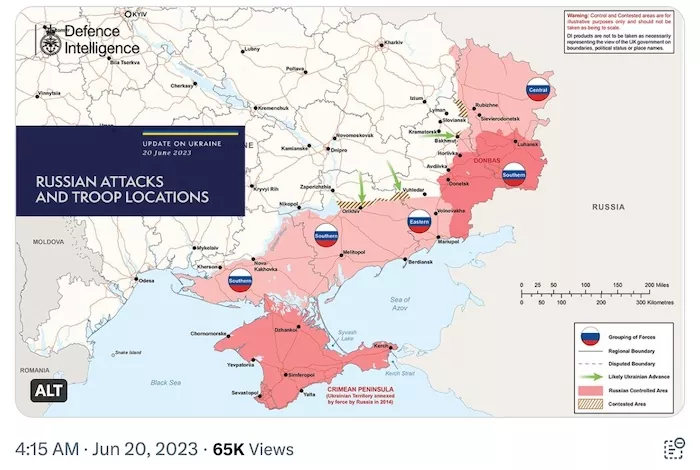
- On 19 June 2023, Wagner Group owner Yevgeny Prigozhin said that he was expecting a reply from the Russian MoD regarding a ‘contract’ of his own drafting which he had delivered to the ministry three days before.
- This follows the MoD’s own ultimatum to Wagner and other ‘volunteer formations’ to sign contracts with the MoD by 01 July 2023. Although the content of Prigozhin’s document has not been made public, the act of him delivering it raises the stakes, and is highly likely another deliberate effort to undermine the authority of the official military authorities.
- Prigozhin’s tone towards the MoD has become unambiguously confrontational. The MoD almost certainly sees this as deeply unfortunate at a time when it is grappling with Ukraine’s counter-offensive.
- Over the last ten days, Russia has highly likely started relocating elements of its Dnipro Group of Forces (DGF) from the eastern bank of the Dnipro River to reinforce the Zaporizhzhia and Bakhmut sectors.
- This potentially involves several thousand troops from the 49th Army, including its 34th Separate Motorised Brigade, as well as Airborne Forces (VDV) and Naval Infantry units.
- The DGF redeployment likely reflects Russia’s perception that a major Ukrainian attack across the Dnipro is now less likely following the collapse of Kakhovka Dam and the resulting flooding.
Losses of the Russian army
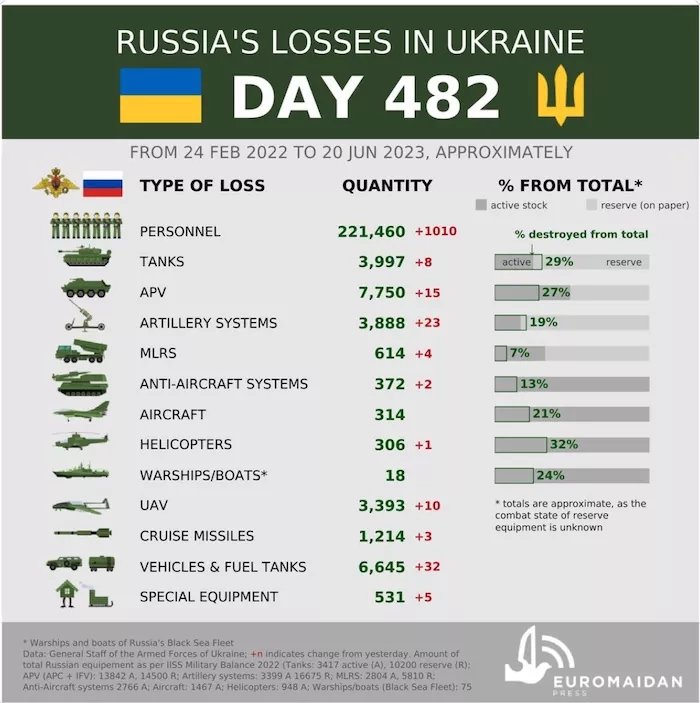
As of Tuesday 20 June, the approximate losses of weapons and military equipment of the Russian Armed Forces from the beginning of the invasion to the present day:
- Personnel – about 221460 (+1010)
- Tanks – 3997 (+8)
- Armoured combat vehicles – 7750 (+15)
- Artillery systems – 3888 (+23)
- Multiple rocket launchers –MLRS - 614 (+4)
- Air defence means – 372 (+2)
- Aircraft - 314 (+0)
- Helicopters - 306 (+1)
- Automotive technology and fuel tanks – 6645 (+32)
- Vessels/boats - 18 (+0)
- UAV operational and tactical level – 3393 (+10)
- Special equipment – 531 (+5)
- Mobile SRBM system – 4 (+0)
- Cruise missiles – 1214 (+3)
SBU destroys Russian Murom-M surveillance system, and six fighting vehicles, Ukrinform reports, citing the Security Service of Ukraine. “Service members of the Security Service of Ukraine (SBU) destroyed a Russian Murom-M surveillance system, six armoured vehicles, a mortar squad, and 16 invaders. […] The invaders placed a radio surveillance system near the contact line to track the movement of the Ukrainian military around the clock.”
Humanitarian
Hundreds of occupied Oleshky residents died because of Russians' refusal to evacuate them after blowing up Kakhovka HPP, Ukrainska Pravda reports, citing Ukraine’s National Resistance Center. “According to preliminary data, more than 500 residents of the temporarily occupied village of Oleshky on the left (eastern) bank of Kherson Oblast died because of the Russians' blowing up of the Kakhovka Hydroelectric Power Plant. The people died because the Russians refused to evacuate those who did not have a Russian-issued passport.
Violating all norms of international humanitarian law and ordinary humanity, the Russians simply left the locals to die. The actions of Russians against civilians have all the hallmarks of genocide, and anyone who joined the abuse of Ukrainians will be justly punished.
The Center of National Resistance appeals to the local population with a request to report the available information about persons who were involved in the blowing up of hydroelectric power stations or harassment of civilians in the [temporarily occupied territories – ed.], to our Telegram bot."
Mortality in occupied Mariupol exceeds COVID-19 period by 2.6 times, Ukrinform reports, citing the National Resistance Center. “The mortality rate in the temporarily occupied city of Mariupol from natural causes has crossed the mark of 400 people per week. This is 2.6 times higher than the peak of the highest COVID death rate,” the report states. Russian invaders destroyed the city’s healthcare system. Most health facilities were converted to serve the wounded Russian soldiers.
Civilians simply cannot receive basic medical care. However, those medical workers who have not betrayed Ukraine are trying to serve civilians without Russian passports, although the invaders strictly prohibit this and threaten them with physical violence, the National Resistance Center noted. The humanitarian crisis is significantly deepening in the temporarily occupied areas.”
EU: Hungary must explain its role in release of Ukrainian prisoners of war, Ukrainska Pravda reports, citing Delfi citing Peter Stano, European Commission spokesperson for foreign affairs and security policy. “The European Commission has stated that Hungary should explain its role in the release of Ukrainian prisoners of war from Russia and its communication on this issue with Kyiv.
Stano was commenting on a statement by the Ministry of Foreign Affairs of Ukraine to the effect that Hungary is holding 11 Ukrainian prisoners of war whom it took out of the Russian Federation, and is not allowing Ukrainian diplomats to visit them. […]
On 19 June, the Ministry of Foreign Affairs of Ukraine stated that the conditions of detention of Ukrainian captives transferred to Hungary from Russia do not allow for them to be considered as having a free status, and the Hungarian side is not engaging in constructive dialogue with Kyiv on this matter.”
Environmental
Aftermath of Kakhovka HPP explosion: 30% of water samples in three regions do not meet the standards, Ukrainska Pravda reports, citing Ministry of Health of Ukraine. "In water bodies of Kherson, Odesa, and Mykolaiv oblasts, individual indicators significantly exceed the established hygienic and sanitary standards. At least 30% of water samples taken from surface reservoirs and recreation areas do not meet hygienic standards (185 out of 579 samples)."
The most dangerous situation is in Odesa Oblast, where the most significant and constant exceedances of sanitary-chemical, microbiological and toxicological indicators have been recorded. The greatest danger is salmonella, rotavirus, eggs and larvae of helminths, E. coli.”
Farmers from Ukraine’s southern regions will need at least eight years to return production to pre-war levels, Ukraine Business News reports. “According to the Ukrainian Agrarian Council, this will not possible until the Kakhovka HPP’s reconstruction. This amount of time will be needed because it will take five years to restore the station, and it will take another two to three years for farmers to reach pre-war indicators.
The Deputy Chairman of the Agrarian Council, Denys Marchuk, says that it will be complicated for farmers in the south to grow vegetables without irrigation. Before the full-scale invasion, a significant part of the borscht set was supplied from the Kherson region, and early vegetables came from the Zaporizhzhia region.
According to the expert, farmers on the left bank of the Kherson region will suffer the most because of the Kakhovka HPP disaster, and it is too early to talk about damages before the region’s liberation. According to the Ministry of Agriculture, about 10,000 hectares of land have been flooded on the right bank of the river.”
The government of Norway will allocate NOK 250 million (over UAH 863 million) for nuclear safety in Ukraine, Ukrinform reports, citing the Ministry of Foreign Affairs of Norway. “Norway is increasing its support for nuclear safety and security in Ukraine in 2023 by NOK 250 million. Russia’s illegal war poses a threat to nuclear safety and security in Ukraine. A nuclear accident in Ukraine would have consequences not only for Ukraine itself, but also beyond the country’s borders,” the report says. In particular, Norway will provide NOK 100 million to support the work of the International Atomic Energy Agency (IAEA) experts in Ukraine.
In addition, Norway is increasing its funding for nuclear safety and security cooperation with Ukraine by NOK 150 million. This funding will be used to reduce the risk of accidents and incidents involving the release of radioactive substances, and to reduce the risk of radioactive material falling into the wrong hands.
As reported, Norway was one of the first countries to deliver equipment to Ukraine to enhance nuclear safety and security following Russia’s full-scale invasion in February 2022. As early on as March 2022, Norway provided equipment to the Ukrainian border control authorities and to the Rivne nuclear power plant.”
Legal
UK Announced new route of "Voluntary Fund Transfer" to Ukraine from sanctioned Russians, European Pravda reports. “The newly announced legislation by the UK Foreign Secretary James Cleverly allows Russian subjects to sanctions to donate their frozen assets towards the restoration of Ukraine. […] These new measures – on top of our largest ever sanctions package – show the UK is ready and able to clear new paths to ensure Russian money reaches Ukrainian people, said Jeremy Hunt, British Chancellor of the Exchequer.
The UK Foreign Office noted that sanctioned Russians who say they support Ukraine, will now also have a way to do the right thing – via a route to donate their frozen funds for Ukrainian reconstruction. It points out that this will be a voluntary process whereby sanctioned individuals may apply for funds to be released for the express purpose of supporting Ukraine's recovery and reconstruction
The UK Foreign Office clarified that there will be no coercion of individuals to encourage them to transfer funds, nor any offer of sanctions relief in return for making a donation. There are no negotiations with these individuals, no agreements with them about what they will receive in return. It concerns those individuals who currently have no access to this money and want to voluntarily transfer the funds to Ukraine, explained a source in the British government to "European Pravda."
Furthermore, according to the source, the UK government does not plan to publicly disclose the list of those who have decided to voluntarily donate frozen assets to Ukraine.”
Support
Macron announces deployment of SAMP/T system in Ukraine, Ukrainska Pravda reports, citing Rai News. “French President Emmanuel Macron announced on Monday that the French-Italian SAMP/T anti-missile defence system is now being successfully deployed in Ukraine. […] This was the first official confirmation of the arrival of SAMP/T in Ukraine following numerous media reports. […]
SAMP/T-MAMBA is Europe's first long-range anti-missile system. It can destroy enemy aircraft at a range of 3 to 100 km and ballistic missiles at a range of 3 to 25 km. The defeat height is up to 25 km.»
US F-16 Defence Manufacturer Ready to Train Ukrainian Pilots, European Pravda reports. “US defence manufacturer Lockheed Martin has said it stands ready to help Ukrainian pilots fly and maintain its F-16 fighter jets if NATO states agree to send them to help the country against Russian aggression. According to Financial Times, any decision would be made only as a result of discussions between Ukraine, the US and other western allies.
We are standing by, ready to not only backfill need as it arises with new F-16 builds but also any modifications to F-16s as well as training, equipment and systems, said Frank Saint John, Lockheed Martin chief operating officer. St John […] said Ukraine's armed forces had shown an incredible learning aptitude. Lockheed weapons, including the guided multiple launch rocket system (GMLRS) and Javelin missiles, have played a prominent role on the battlefield.
The Ukrainians rapidly mastered the use of those systems and employed them with great effectiveness so I am very confident that Ukrainian pilots are going to master the F-16 and be able to use it very effectively in short order, Saint John added. […]
The issue of providing Ukraine with F-16 fighter jets was discussed within the framework of the Defence Contact Group of Ukraine (Ramstein format) last week. After the meeting, it became known that by July, Ukraine's partners plan to approve a training program for Ukrainian pilots, engineers, and technicians on the F-16, and the training itself will take place at a specially created center in one of the European countries.”
Germany only has 20,000 high explosive artillery shells left – report, Reuters reports. “Germany's armed forces only have around 20,000 high explosive artillery shells left, magazine Der Spiegel wrote on Monday citing confidential defence ministry papers prepared to convince the budget committee of the need for urgent purchases. Countries like Germany have rushed to send supplies of 155m artillery rounds used by howitzers to Ukraine in the wake of its invasion by Russia in February 2022, running down stocks for their own defence.
Germany's military needs to build up an inventory of some 230,000 shells by 2031 to comply with NATO goals to have enough artillery to withstand 30 days of intensive combat, Der Spiegel wrote.
The defence ministry did not immediately reply to a request for comment. The ministry aims to present the budget committee with nine contracts for the accelerated purchase of artillery and tank ammunition in coming months, Der Spiegel wrote.”
Kyiv in talks with Western weapons makers about setting up production in Ukraine -minister, Reuters reports. “Ukraine is in negotiations with Western arms manufacturers to boost production of weapons, including drones, and could sign contracts in coming months, a Ukrainian minister told Reuters. Since Russia's invasion of Ukraine last year Ukraine has been scrambling to secure weapons ranging from munitions to rocket launchers to missiles. […] Sergiy Boyev, deputy minister for Strategic Industries in Ukraine, said Kyiv was in talks with manufacturers from Germany, Italy, France and eastern Europe about them producing weapons in Ukraine itself.
We are in very detailed discussions with them. And we are certain that we will have the contracts agreements signed within the next few months, Boyev told Reuters on the sidelines of the Paris Airshow. In May, Ukraine's President Volodomyr Zelenskyy said the country was working with British defence company BAE Systems to set up a Ukrainian base to both produce and repair weapons from tanks to artillery. No deal has been signed yet.
In encouraging foreign defence firms to produce arms in Ukraine, Kyiv could more efficiently meet its own needs while also building up its defence industry to target global customers at a time when it's looking to create jobs for Ukrainians. The future deterrence of aggression will require a strong defence industry in Ukraine, a strong Ukrainian armed forces, Boyev said.
That's why we think international partners coming to Ukraine, setting up production and making Ukraine part of the security framework for the free world is so essential.
At the Paris Airshow on Monday, Boyev was courting dronemakers in particular, ranging from major international defence firms to small suppliers. He declined to say which companies he met with. We are discussing different levels of cooperation. And some of the companies say that they are willing to come and invest and produce drones, he said.
Turkish defence company Baykar said late last year that it still planned to complete construction of a manufacturing plant in Ukraine in two years. Baykar had announced plans to build the plant shortly before the Feb. 24, 2022 invasion of Ukraine by Russia.
Drones have been used extensively by both Moscow and Kyiv's forces during the war. Kyiv says it is expanding its drone programme for both reconnaissance and attacking enemy targets over an increasing range. Türkiye, Norway and the United States are among the countries that have been supplying Ukraine with drones, but as the war intensifies more are needed.
Negotiations on producing drones could take longer, but Boyev said production in Ukraine could be an effective way to capitalise on the country's existing drone expertise and create jobs in western and central Ukraine.”
Shmyhal outlines key aspects of Ukraine Recovery Conference in London, Ukrinform reports. “Prime Minister of Ukraine Denys Shmyhal outlined three key aspects that will be focused on at the Ukraine Recovery Conference in London. Soon, a large international conference on the restoration of Ukraine will begin in London. This is a continuation of the movement towards a major reconstruction that we started a year ago in Lugano. Our goal is to mobilize as much international support as possible and establish mechanisms by which this aid will arrive in a timely and rhythmic manner. It is about both quick recovery – what is needed here and now – and long-term reconstruction," Shmyhal said at the Cabinet’s meeting on Monday.
He noted that, according to the World Bank's estimates, $14.1 billion will be needed for the rapid recovery of Ukraine in 2023. According to him, the sum will increase after the Russian terrorist attack on the Kakhovka HPP. Thus, Shmyhal noted, Ukraine is already working on an accurate assessment of the damage caused.
During the conference in London, we will focus on three key aspects. The first is rapid recovery, energy, critical social infrastructure, especially housing recovery. We need to mobilize the necessary resources for reconstruction. During the conference, there will be a meeting of the Multi-agency Donor Coordination Platform, the so-called ‘financial Ramstein’. We expect efficient solutions, Shmyhal said.
The second aspect is the attraction of private investments. We will present the most promising areas for investment. We will take an important step in the issue of military and political risk insurance for investors, the Head of Government added.
And the third aspect, according to him, is the regions. We strive to activate horizontal connections between Ukrainian communities and international partners for the implementation of restoration projects. More than 200 projects have already been launched, we want there to be many more of them. Following the conference in London, we expect to sign several important agreements, memoranda, and declarations that will speed up our reconstruction and development, Shmyhal noted.
As reported, Ukraine Recovery Conference will be held in London on June 21 to determine the priority, medium-term, and long-term tasks for the post-war reconstruction and modernization of Ukraine.”
New Developments
- China confirms it won't supply weapons to Russia – Blinken, Ukrainska Pravda reports, citing BBC News Russian, quoting Antony Blinken, United States Secretary of State. "We – and other countries – have received assurances from China that it is not and will not provide lethal assistance to Russia for use in Ukraine. [The US had not] seen any evidence that contradicts that. What we do have ongoing concerns about, though, are Chinese firms – companies that may be providing technology that Russia can use to advance its aggression in Ukraine."
- Ukrainian Parliament proposes to recognize Belarus as an aggressor state and break off diplomatic relations, Ukrainska Pravda reports, citing European Pravda, citing MP Yaroslav Yurchyshyn’s reporton Monday. “A group of people's deputies registered in the Verkhovna Rada of Ukraine [the Ukrainian parliament – ed.] a draft resolution recognizing Belarus as an aggressor country, as well as a call to break off diplomatic relations with the country.”
- Russia claims Ukraine has resumed work on creating "dirty bomb", Ukrainska Pravda reports, citing TASS. “Sergey Naryshkin, Director of the Foreign Intelligence Service of Russia, has said that Ukraine may have resumed its work on creating what Russia claims to be a "dirty bomb". Naryshkin claimed that Russian Foreign Intelligence has obtained information which indicates that Kyiv may have resumed working on the creation of a dirty nuclear bomb. He also alleged that the Ukrainian government wants to send a batch of irradiated fuel from the Rivne Nuclear Power Plant for reprocessing. The Russian Foreign Intelligence Director called on the International Atomic Energy Agency (IAEA) and the European Union to pay attention to Kyiv’s actions". Warning: The Russian Foreign Intelligence is not deemed credible.
- London conference to consider financial aid for Ukraine after 2023, Ukrinform reports, citing the President of the European Commission Ursula von der Leyen following a telephone conversation with British Prime Minister Rishi Sunak. “Good call with Rishi Sunak ahead of the London Ukraine Conference. We spoke about financial support for Ukraine after 2023, opportunities and challenges for AI - a discussion to have with like-minded partners and companies and fighting migrant smuggling," von der Leyen wrote. As reported, an International Conference on Ukraine's Recovery will be held in London on June 21 to identify priority, medium-term and long-term tasks for the post-war reconstruction and modernization of Ukraine.”
- Putin's press secretary comments on Russia's decision not to allow UN mission to left bank of Kherson Oblast, Ukrainska Pravda reports, citing TASS. “Denise Brown, the UN Humanitarian Coordinator in Ukraine, has said that Russia refused to allow the UN humanitarian mission to reach people on the left bank of Kherson Oblast – those who suffered from the consequences of destruction of the Kakhovka hydroelectric power plant. Dmitry Peskov, the spokesman for the Russian dictator, has said that the Russian occupation forces will not allow UN representatives to visit the left bank of Kherson Oblast flooded after the blowing up of the Kakhovka hydroelectric power plant, as it is difficult for them to guarantee security".
- G7 ambassadors pledge to redouble efforts against Russia's missile programme, Ukrainska Pravda "The G7 Ambassadors stand with all Ukrainians enduring the constant threat and destruction of Russia’s missile attacks. We are redoubling our efforts to deny Russia the components it uses to strike civilians and infrastructure in Ukraine, they said. The statement was issued in response to Russia's latest attack on Kryvyi Rih on the night of 14 June, which resulted in the destruction of a high-rise building. The Kh-101 missile that hit the building was manufactured in April 2023 and, accordingto the Ukrainian side, contained about 50 Western-made components that bypassed sanctions to enter Russia.”
- EU says Ukraine has fulfilled only 2 of 7 candidate criteria, but report will be "positive", Ukrainska Pravda reports, citing Reuters. “According to the European Commission, Ukraine has fulfilled two of the seven conditions for the start of EU membership negotiations, at the same time Brussels notes the progress made despite Russia's full-scale war. In the preliminary oral assessment of progress towards membership, which the European Commission will provide on 22 June, it will state that Ukraine has fully implemented two of the seven recommendations related to judicial reform and media legislation. There is progress. The report will be moderately positive. It's not about embellishing reality but recognising progress, there have been prominent anti-corruption cases to name, for example, a source told Reuters on conditions of anonymity.”
- UK to not lift sanctions against Russia until Ukraine is compensated, European Pravda “The United Kingdom has introduced new legislation that will allow it to keep sanctions against Russia until Moscow compensates Ukraine. According to the UK Secretary of State for Foreign press service, the announcement on the new legislation was made by Foreign Secretary James Cleverly. He stated that the new legislation will allow the British government to maintain sanctions against Russia until compensation is paid to Ukraine and introduces a new pathway for frozen Russian assets that can be donated towards Ukraine's recovery. These new measures were announced ahead of a major conference on Ukraine's recovery in the United Kingdom this week.”
Assessment
- On the war.
The Institute for the Study of War has made the following assessment as of June 19, 2022:
Russian forces made gains in the Kupiansk area and continued ground attacks along the Svatove-Kreminna line on June 19. Geolocated footage posted on June 19 shows that Russian forces advanced into the northern part of Vilshana (about 15km northeast of Kupiansk) on an unspecified date. The Ukrainian General Staff additionally reported that Russian forces conducted unsuccessful offensive operations near Novoselivkse (15km northwest of Svatove), Yampolivka (17km west of Kreminna), Torske (14km west of Kreminna), west of Dibrova (5km southwest of Kreminna), Hryhorivka (10km south of Kreminna), and Spirne (25km south of Kreminna). Ukrainian Deputy Defense Minister Hanna Maliar noted that Russian forces are conducting active offensive operations along the Kupiansk-Lyman line in an effort to regain the initiative. One Russian milblogger claimed that elements of the 76th Guards Airborne (VDV) Division conducted offensive operations near Kreminna. Another Russian milblogger claimed that Ukrainian troops unsuccessfully attempted to break through Russian defensive lines in the Kreminna area. […]
Ukrainian forces continued counteroffensive operations while Russian forces conducted limited ground attacks near Bakhmut on June 19. A Russian source claimed that Ukrainian forces advanced near Krasnopolivka (12km northeast of Bakhmut) and conducted additional attacks near Berkhivka (6km north of Bakhmut), Yahidne (immediately north of Bakhmut), Klishchiivka (7km southwest of Bakhmut), Kurdyumivka (14km southwest of Bakhmut), and Ozarianivka (13km south of Bakhmut). Ukrainian Deputy Defense Minister Hanna Maliar stated that Ukrainian forces continued to advance on the flanks of Bakhmut in the last week. The Ukrainian General Staff reported that Ukrainian forces repelled limited Russian offensive operations near Orikhovo-Vasylivka (11km northwest of Bakhmut).
Russian and Ukrainian forces conducted limited attacks on the Avdiivka-Donetsk City line and made marginal gains as of June 19. Geolocated footage posted on June 18 shows that both Ukrainian and Russian forces have advanced near Pobieda (just southwest of Donetsk City), indicating that Ukrainian forces advanced southeast of Pobieda and Russian forces south of Pobieda. The Ukrainian General Staff reported that Russian forces conducted unsuccessful offensive operations near Avdiivka, Krasnohorivka (8km north of Avdiivka), Marinka (immediately southwest of Donetsk City), Pobieda, and Novomykhailivka (about 30km southwest of Donetsk City). A Russian milblogger claimed that Russian forces also attacked near Vodyane (7km southwest of Avdiivka) and Stepove (3km northwest of Avdiivka) and that Ukrainian troops made marginal advances near Vesele (3km northeast of Avdiivka). Geolocated footage published on June 18 shows Russian forces using a T-54 or T-55 tank as a vehicle-borne improvised explosive device (VBIED) near Pobieda, but Ukrainian forces destroyed the tank before it reached Ukrainian positions. Russian forces have previously used older vehicles as VBIEDs.
Ukrainian forces conducted limited ground attacks along the administrative border between western Donetsk and eastern Zaporizhzhia oblasts on June 19. The Russian MoD claimed that elements of the 40th Naval Infantry Brigade (Pacific Fleet) repelled a Ukrainian counterattack near Novodonetske (10km southeast of Velyka Novosilka). Russian milbloggers claimed that elements of the 1st Separate Guards Motorized Rifle Battalion (Donetsk People‘s Republic “Slavic” Brigade) and the 37th Motorized Rifle Brigade (36th Combined Arms Army, Eastern Military District) repelled Ukrainian forces near Urozhaine (10km south of Velyka Novosilka). A milblogger claimed that Russian forces repelled an attack near Pryiutne (17km southwest of Velyka Novosilka). The Ukrainian General Staff reported that Russian forces conducted limited ground attacks near Vuhledar (30km due east of Velyka Novosilka).
Ukrainian forces conducted limited ground attacks in western Zaporizhzhia Oblast on June 19. Geolocated footage published on June 19 shows that Ukrainian forces liberated Pyatykhatky (23km southwest of Orikhiv). Some Russian sources either claimed that Russian forces then recaptured Pyatykhatky or characterized the settlement as a “grey zone.” Russian milbloggers claimed that fighting is ongoing near Novodanylivka (6km south of Orikhiv) and Robotyne (15km south of Orikhiv). Russian sources claimed that elements of the volunteer “Sudaplatov” Battalion are operating near Pyatykhatky and that elements of the 3rd Battalion of the 291st Motorized Rifle Regiment (42nd Motorized Rifle Division, 58th Combined Arms Army, Southern Military District) are operating near Orikhiv.
Russian sources claimed that Ukrainian forces conducted a missile strike against a Russian rear area in occupied Donetsk Oblast. Russian sources claimed that Ukrainian forces conducted a HIMARS strike on Volnovakha (54km southwest of Velyka Novosilka).
Ukrainian forces conducted counteroffensive operations in at least three sectors of the frontline and made gains on June 19. A Russian milblogger reported that Ukrainian troops continued attacks northwest, northeast, and southwest of Bakhmut on June 19 and claimed that Ukrainian forces advanced near Krasnopolivka (about 12km northeast of Bakhmut). Ukrainian Deputy Defense Minister Hanna Maliar additionally announced that over the past week, Ukrainian troops in the Tavrisk (Zaporizhzhia) direction have advanced up to seven kilometers and liberated 113 square kilometers of territory, including eight settlements in western Donetsk and western Zaporizhzhia oblasts. Russian milbloggers claimed that Ukrainian troops attacked south of Velyka Novosilka in western Donetsk Oblast. Geolocated footage posted on June 19 confirms that Ukrainian troops liberated Pyatykhatky, about 25km southwest of Orikhiv in western Zaporizhzhia Oblast. Milbloggers also reported fighting south and southwest of Orikhiv over the course of the day on June 19. The UK Ministry of Defense (MoD) assessed on June 19 that Russia has likely deployed large portions of the Dnipro Grouping of Forces from the east (left) bank of Kherson Oblast to the Zaporizhzhia and Bakhmut directions to respond to Ukrainian counteroffensive actions over the past 10 days.
Russian forces conducted drone and missile strikes targeting southern Ukraine on June 19. The Ukrainian General Staff reported that Russian forces launched four Kalibr cruise missiles and four Shahed-131/136 drones at Ukraine and stated that Ukrainian air defenses destroyed all the drones and missiles. Ukrainian officials reported that Russian forces launched the Kalibr cruise missiles from a submarine in the Black Sea and the Shahed drones from the eastern coast of the Sea of Azov.
US Secretary of State Antony Blinken reported that the Chinese government reiterated that it is not providing, and will not provide, lethal assistance to Russia for use in Ukraine. Blinken reported on June 19 that the United States has not seen evidence contradicting Beijing’s claims. Blinken expressed concern that Chinese companies may be providing Russia technology that it can use in the war against Ukraine, however.
US defense manufacturer Lockheed Martin indicated that it is ready to help Ukraine fly and maintain Lockheed’s F-16 fighter jets if NATO states agree to send them to Ukraine. The Financial Times quoted Lockheed Martin Chief Operating Officer (COO) Frank St. John as stating that Lockheed is prepared to build new F-16s; modify existing airframes; and provide F-16 training, equipment, and systems support if NATO agrees to supply Ukraine with F-16s. US and other Western officials have recently signaled an increased willingness to provide Ukraine with F-16s, as ISW has previously reported.
Kremlin-affiliated Russian tech giant Yandex claimed that international sanctions against Russia prevented the company from providing the Russian Federal Security Service (FSB) with user data in compliance with a Russian security law, resulting in a significant fine. A Moscow court imposed a two million ruble (roughly $23,795) fine against Yandex on June 18 for failing to provide the FSB with unspecified user data for national security reasons.[ A Yandex representative claimed that Yandex did not intend to break Russian law but that international sanctions prevent Yandex from purchasing, installing, and configuring the foreign hardware and software necessary to comply with the law. A Moscow court previously imposed a 400,000 ruble (roughly $4,759) fine against Yandex for the same violation in 2022. While it is unclear how foreign technology products would help Yandex comply with Russian law, the situation demonstrates that international sanctions have impacted some aspects of the Russian technology sector and national security apparatus.
Key Takeaways
- Ukrainian forces conducted counteroffensive operations in at least three sectors of the frontline and made gains on June 19.
- Russian forces conducted drone and missile strikes targeting southern Ukraine on June 19.
- US Secretary of State Antony Blinken reported that the Chinese government reiterated that it is not providing, and will not provide, lethal assistance to Russia for use in Ukraine.
- US defense manufacturer Lockheed Martin indicated that it is ready to help Ukraine fly and maintain Lockheed’s F-16 fighter jets if NATO states agree to send them to Ukraine.
- Kremlin-affiliated Russian tech giant Yandex claimed that international sanctions against Russia prevented the company from providing the Russian Federal Security Service (FSB) with user data in compliance with a Russian security law, resulting in a significant fine.
- Russian forces made gains in the Kupiansk area and continued ground attacks along the Svatove-Kreminna line.
- Ukrainian forces continued counteroffensive operations while Russian forces conducted limited ground attacks near Bakhmut.
- Russian and Ukrainian forces conducted limited attacks on the Avdiivka-Donetsk City line and made marginal gains.
- Ukrainian forces conducted limited ground attacks along the administrative border between western Donetsk and eastern Zaporizhzhia oblasts.
- Ukrainian forces conducted limited ground attacks in western Zaporizhzhia Oblast.
- The Wagner Group continues efforts to expand its recruitment pool in the wake of significant losses in Ukraine.
Russian sources claimed that a car carrying a Zaporizhzhia Oblast occupation official exploded in Simferopol, occupied Crimea.
Report by German Defence Ministry: Ukrainian Saboteurs Successfully Operate behind Russian Forces, Ukrainska Pravda reports. “The Ministry of Defence of Germany has analysed the course of military operations in Ukraine, which indicates that Ukrainian military forces are attempting to weaken the Russian army through diversions far beyond the front line. According to Bild, citing the report, pro-Ukrainian sabotage groups disrupted the main railway connection in the territory of the Zaporizhzhia region, occupied by Russian forces. Furthermore, the railway in occupied Crimea came under attack by saboteurs.
According to the Ministry of Defence of Germany, this proves that Ukrainian forces can still operate in regions under Russian control, far beyond the front line. The German ministry is also analysing the sabotage of an ammonia pipeline in the Kharkiv region in early June. The report states that Ukraine's involvement in the destruction of the ammonia pipeline cannot be ruled out.
As stated by the German Ministry of Defence, Russian occupation forces are defending the front line from prepared positions with all available forces. At the same time, the Russian army increasingly relies on aerial, missile, and unmanned attacks to inflict losses on Ukrainian forces.
Russian forces are under pressure in the area of Bakhmut, pointed out the German agency. Additionally, the Russian army presumably no longer controls the entire city.
Earlier, Colonel Margo Grosberg, Chief of the Estonian Defence Forces' Intelligence Centre, stated that the Armed Forces of Ukraine are conducting reconnaissance to identify weak points in the defensive positions of Russian occupation forces. According to him, there will be no active counteroffensive operations in the coming week.»
Ukraine says 'biggest blow' in offensive is yet to come, Reuters reports. “Ukraine's Deputy Defence Minister Hanna Maliar said the biggest blow in Kyiv's military campaign is yet to come, but admitted the operation is difficult as Russia throws all it can to stop the offensive. The ongoing operation has several objectives, and the military is fulfilling these tasks, Maliar said on the Telegram messaging app. They are moving as they should have been moving. And the biggest blow is yet to come.
After months of acquiring Western weaponry, training and preparations, Ukraine began the first stage of its counteroffensive two weeks ago to reclaim the nearly fifth of its land now occupied by Russia. The enemy will not easily give up their positions, and we must prepare ourselves for a tough duel, Maliar said.
In fact, that is what is happening right now. The Ukrainian military, which had maintained strict silence about the campaign for more than a week, has since claimed small victories, saying on Monday that it has liberated several small settlements since. […]
It is impossible to independently verify the military operation along the most contentious points of the frontline, but Reuters was able to confirm that Ukraine's forces have been advancing in the early phase of the counteroffensive. Maliar said that despite Ukraine's forces advancing in multiple directions in the south, Russia's forces push to advance in the east, concentrating its efforts there.”
Ministry of Defense: Russians amassing forces in south, east of Ukraine, Ukrinform reports, citing Deputy Minister of Defense of Ukraine Hanna Maliar. “They simply do not leave the key goal they set, which is the boundaries of Donetsk and Luhansk regions. At the time when they were unable to seize Kyiv with a blitzkrieg, they simply began to set targets gradually. And despite the fact that the offensive of our Armed Forces continues in several directions in the south, the Russians also have their own directions of attack, and they also go on the offensive.
In the east, they have been going on the offensive in four directions, starting from January of this year. These are Mariinka, Avdiivka, Lyman, and Bakhmut directions. And Kupiansk also. And now, in fact, they have intensified in Lyman and Kupiansk directions. And the east is essentially the direction of their main offensive, they do not abandon their goal – to reach the boundaries of Donetsk and Luhansk regions. They really build up reserves there, Maliar said.
She noted that the Russians amass reserves in the south as well, but they strengthen them in the east as well.
In addition, according to her, the Russian invaders increase the number of shelling in the east. In particular, the enemy launched 6,000 strikes, using more than 277,000 rounds, along the frontline in the east over the past week.
Maliar noted that fighting continues both in the east and in the south. The Ukrainian troops go on the offensive in some directions and hold the defence in others. And our enemy is very serious and powerful. This must be understood, Maliar emphasized.”
A Wall Street Journal (WSJ) interview with Russian prisoners of war (POWs) indicates continued significant morale and command issues among frontline Russian units and the continued Russian use of “barrier forces” to shoot retreating soldiers, ISW reports. “WSJ amplified the statements of three unidentified Russian POWs who voluntarily surrendered to Ukrainian forces during Ukrainian counteroffensive operations near Velyka Novosilka, on the administrative border between Donetsk and Zaporizhzhia oblasts.
The POWs reported widespread fear of a Ukrainian counteroffensive among Russian forces on the frontlines. The POWs indicated that the Russian military command sees Russian conscripts and penal recruits as expendable, and claimed Russian officers order injured personnel deemed unfit for service back to the front line and use “barrier forces” to prevent penal recruits in “Storm-Z” units from retreating. Barrier forces are specialized units that threaten to shoot their own personnel either to prevent retreats or to force them to attack, and unverified social media footage recently circulated depicting Russian barrier troops shooting retreating Russian forces in Ukraine. The POWs also indicated that Russian forces struggle to supply and staff their units, including struggling to crew tanks and armored vehicles. The POWs expressed concern about returning to Russia in a POW exchange due to Russian laws prohibiting voluntary surrender to the enemy.”
- Consequences and what to do?
GE stops servicing gas power turbines in Russia – Kommersant, Reuters reports. “General Electric has stopped servicing gas turbines at thermal power plants in Russia, the Russian business daily Kommersant reported on Tuesday, citing sources in power generating companies.
General Electric suspended its operations in Russia after Moscow invaded Ukraine, with the exception of providing essential medical equipment and supporting existing power services in the region. Kommersant reported that General Electric "without explanation" stopped servicing gas turbines at Russian thermal power plants on Monday.”
Despite sanctions, Russia is buying American sniper rounds and other ammunition from the EU, and electronics used in Russian missiles are produced in the US, Ukraine Business News reports. “As Politico writes, Russian-sanctioned companies Promtechnologiya, which manufactures Orsis T-5000 rifles, and Tetis purchased hundreds of thousands of cartridges manufactured by the American company, Hornady. The bullets were highlighted in a video by the Wagnerites, where the sniper praises the Orsis T-5000 rifle and notes that it uses Western 338 caliber ammunition. The journalists documented these munition supplies, utilizing data from the Russian state register and international customs classification codes.
During the investigation the publication also found declarations by several other Russian companies for ammunition manufactured in Germany, Finland, and Türkiye.
In addition, according to the Yermak-McFaul group, companies from the US account for 81% of electronic components, Switzerland – 8%, and Japan and Germany – 3.5% each. Electronic components for missiles enter the Russian Federation primarily through third countries.”
Hans Petter Midttun: According to the German magazine Der Spiegel, the German armed forces only have around 20,000 high-explosive artillery shells left.
Germany's military needs to build up an inventory of some 230,000 shells by 2031 to comply with NATO goals to have enough artillery to withstand 30 days of intensive combat, Der Spiegel wrote. (Reuters)
If true, the information is shocking. Nine years after the war started, one of the supposedly strongest military powers in Europe is left with less than one day of supplies to defend itself or any of its allies under the auspice of NATO collective defence.
To put it into a proper perspective, Russia allegedly launched 6,000 strikes, using more than 277,000 shells along the eastern frontline over the past week only. Russia has been using massive artillery strikes along the 1,200 km long frontline for 482 days already. While the daily rate of fire varies the total ammunition expenditure is massive.
According to Spiegel, Germany will have enough ammunition to fight for 30 days in 8 years. Not tomorrow but in 8 years.
The numbers are equivalent to nearly six days of Russian artillery barrages. The discrepancy in numbers reflects in part the cost-effectiveness of employing smart ammunition and a superior Command, Control, Communications, Computers (C4) Intelligence, Surveillance and Reconnaissance (ISR).
That said, cost-effectiveness does not meet the requirements of a war of attrition. During the last 16 months, the US alone has supplied Ukraine with Over 2,000,000 155mm artillery rounds and over 7,000 precision-guided 155mm artillery rounds. That’s 8,7 times more than Germany allegedly plans to procure over the next 8 years.
The sad fact is that Germany isn’t the only NATO country facing sustainability problems. More importantly, this information isn’t new to the Alliance.
The present status of the American and European defence industries – or rather, their inability to meet the urgent need for weapons and ammunition anytime soon, is a glaring consequence of decades of underfinancing of the defence sector. In the race to arm Ukraine, the US faces cracks in its manufacturing might, The Washington Post reported on 9 March.
Research conducted by the Center for Strategic and International Studies (CSIS) shows the current output of American factories may be insufficient to prevent the depletion of stockpiles of key items the United States is providing Ukraine. Even at accelerated production rates, it is likely to take at least five years to recover the inventory of Javelin antitank missiles, Stinger surface-to-air missiles and other in-demand items.
In Europe, the problems are equally grave.
In Germany, amid plans for a dramatic military expansion, its ammunition supply is believed to be sufficient for two days of fighting. In one war game, British stocks lasted eight days.
In August 2022, I pointed out that the West is running out of weapons it can supply Ukraine. 10 months ago I stressed that a Western military intervention in Ukraine is inevitable. It is bound to happen despite the US and NATO’s continued declarations that they will not deploy military forces to help defend Ukraine.
The West is running out of weapons it can supply Ukraine which it can use with no or limited training. The options left for us are either to see Ukraine fail or to provide it with both the weapons and the personnel needed to operate them efficiently.
In the article “The new strategy NATO needs to avoid a protracted war in Ukraine” I argued that the US and Europe aren’t doing enough to change the military balance and risk a war they are ill-prepared to meet: A protracted war.
In my humble opinion, and recognizing the discord within NATO and its inability to act according to its late Level of Ambition, a coalition of the willing based on key members of the Alliance could change the military balance in weeks if it so decided. It “only” needs to bring the full scope of its military power to bear. By deploying the tools the US and Europe have refused to employ until now – their maritime and air power – they could fundamentally shift the military balance in favour of Ukraine and Europe.
They would present the Russian Federation with a dilemma: Abort the war against one or face the war against thirty-two. Withdraw, or risk losing your conventional forces to a technologically superior military alliance.
16 months after the full-scale war started, this option is still not on the table. The West remains committed to a “no boots on the ground” (or in the air and at sea) strategy.
The West is, however, fast reaching a long-predicted milestone. The report on German stockpiles confirms the writing on the wall.
In the same manner, as logistics forced Russia to adjust its initial operational objectives for the invasion, logistics are about to force the Alliance to change its strategy. NATO will need to start acting according to NATO’s strategic concept 2010-2022: Stop ongoing conflicts threatening the security of its member states.
It's high time to commit to the security and stability of all NATO members as some of them are already committed to defending themselves against Russia in Ukraine.
If they want to be smart about it, they would declare Ukraine a NATO member from 1st August during the Vilnius summit. That would leave Russia sufficient time to withdraw and NATO time to prepare.

